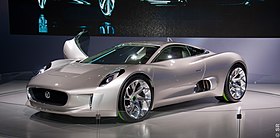Jaguar C-X75
| Jaguar C-X75 | |
|---|---|
 |
|
| Overview | |
| Manufacturer | Jaguar |
| Production | 2010 (Concept car) |
| Body and chassis | |
| Class | Sports car |
| Body style | 2-door coupé |
| Powertrain | |
| Engine | 4 electric motors with diesel micro gas turbine range extenders |
| Chronology | |
| Predecessor | Jaguar XJ220 |
Jaguar C-X75 is a hybrid-electric, 2-seat, concept car produced by Jaguar which debuted at the 2010 Paris Motor Show. The C-X75 concept produces 778 horsepower through four YASA electric motors, each of which drives one of the four wheels. The batteries driving these motors are recharged using two diesel-fed micro gas turbines instead of a conventional four-stroke engine. It is described as an ideas model that will influence future design and technology.
In May 2011 Jaguar announced plans to build from 2013 until 2015 a limited production of the Jaguar C-X75, with a downsized, boosted petrol engine instead of the micro gas turbines in the concept car. The plug-in hybrid supercar price was estimated between GB£700,000 – GB£900,000 (US$1.15 – US$1.48 million) depending on local market and taxes. A maximum of 250 cars were planned to be built in partnership with Formula One team Williams F1. The production version was expected to have an all-electric range of 50 km (31 mi). In December 2012 the carmaker announced the cancellation of production due to the ongoing global economic crisis. The car was featured in Spectre, the twenty-fourth James Bond film.
In terms of performance, Jaguar envisioned a goal of their future super car reaching 330 km/h (205 mph) and accelerating from 0 to 100 km/h (0 to 62 mph) in 3.4 seconds and 80 to 145 km/h (50 to 90 mph) in 2.3 seconds. It is powered by four 145 kW (194 hp) electric motors – one for each wheel – which produce 780 hp (582 kW) and a total torque output of 1,600 N·m (1,180 lbf·ft). Inherent in the drivetrain is the ability to independently drive each wheel across the full speed range, known as Torque Vectoring. Each motor weighs 50 kilograms (110 lb).
...
Wikipedia
